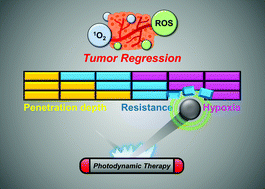Overcoming barriers in photodynamic therapy harnessing nano-formulation strategies
Abstract
Photodynamic therapy (PDT) has been extensively investigated for decades for tumor treatment because of its non-invasiveness, spatiotemporal selectivity, lower side-effects, and immune activation ability. It can be a promising treatment modality in several medical fields, including oncology, immunology, urology, dermatology, ophthalmology, cardiology, pneumology, and dentistry. Nevertheless, the clinical application of PDT is largely restricted by the drawbacks of traditional photosensitizers, limited tissue penetrability of light, inefficient induction of tumor cell death, tumor resistance to the therapy, and the severe pain induced by the therapy. Recently, various photosensitizer formulations and therapy strategies have been developed to overcome these barriers. Significantly, the introduction of nanomaterials in PDT, as carriers or photosensitizers, may overcome the drawbacks of traditional photosensitizers. Based on this, nanocomposites excited by various light sources are applied in the PDT of deep-seated tumors. Modulation of cell death pathways with co-delivered reagents promotes PDT induced tumor cell death. Relief of tumor resistance to PDT with combined therapy strategies further promotes tumor inhibition. Also, the optimization of photosensitizer formulations and therapy procedures reduces pain in PDT. Here, a systematic summary of recent advances in the fabrication of photosensitizers and the design of therapy strategies to overcome barriers in PDT is presented. Several aspects important for the clinical application of PDT in cancer treatment are also discussed.



 Please wait while we load your content...
Please wait while we load your content...